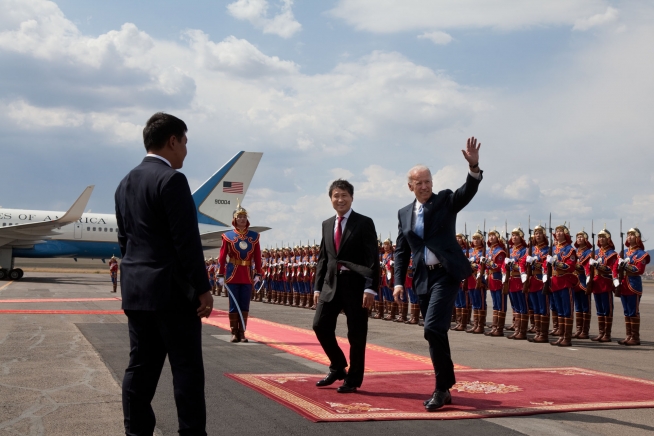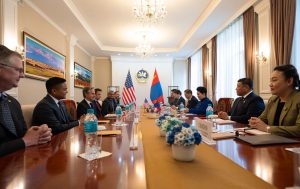Mongolia’s strategic partnership with the United States plays an important role in its third neighbor policy and economic diversification efforts. Throughout history, changes in U.S. administrations have shaped Mongolia-U.S. bilateral relations and economic activities. With the U.S. general election coming up on November 5, it is a good time to assess Ulaanbaatar and Washington’s strategic partnership under the Biden administration.
In 2021, when Joe Biden became the president of the United States, one of the major foreign policy goals of the new administration was to restore U.S. leadership in the Indo-Pacific region. Having previously served as a vice president to Barack Obama for two consecutive terms, Biden’s views on East Asia, especially on partnerships with democratic states like Mongolia, were well-established when he took office. Obama’s “Pivot to Asia” strategy included Mongolia as an important partner and a contributor to peace and security in the region, and this had a great influence on Biden’s view of Mongolia. But Biden’s support for Mongolia’s democracy was well-rooted before he was elected as vice president.
As former U.S. ambassador to Mongolia Jonathan Addleton wrote, when Biden was serving as a senator of Delaware, he supported a bipartisan Senate resolution to recognize Mongolia’s democracy and highlight “the shared democratic values.” The resolution also “expressed appreciation for the presence of Mongolian peacekeepers in Iraq, Afghanistan, Sierra Leon, and Kosovo.”
Under the Obama administration, Mongolia and the U.S. forged stronger defense ties, and U.S. aid to Mongolia reached $268 million in 2014. Biden himself played a key role in those developments.
In 2011, during Mongolian President Elbegdorj Tsakhia’s administration, Biden became “the first U.S. vice president to visit Mongolia since Henry Wallace’s trip in July 1944, more than 67 years earlier,” Addleton noted. Biden’s trip to Mongolia as vice president paved the way for Ulaanbaatar and Washington to upgrade their relations to strategic partners in the years to come.

Then-U.S. Vice President Joe Biden and then-Mongolian Prime Minister Batbold Sukhbaatar walk down the red carpet during an arrival ceremony at Chinggis Khan International Airport in Ulaanbataar, Mongolia, Aug. 22, 2011. Official White House Photo by David Lienemann.
Addleton recalled the advice Biden had passed on to the Mongolian government: to “strengthen the country’s economic links with the United States while also going forward on a long-delayed ‘transparency agreement’ aimed at improving Mongolia’s business and commercial environment and making it more transparent.”
While economic links have indeed grown, transparency remains an issue even 13 years later. The U.S. State Department’s 2024 Investment Climate Statement flagged a lack of transparency and predictability as obstacles for U.S. investment to Mongolia. While Mongolia has ratified the Transparency Agreement – the one Biden pushed for – the State Department noted that “the [Mongolian] government is more than six years behind in its commitment to implement public-notice and comment periods for new laws and regulations affecting international trade and investment.”
Eight years after Biden’s trip to Mongolia, in 2019, U.S. President Donald Trump and his counterpart, Mongolian President Battulga Khaltmaa, upgraded bilateral relations to a strategic partnership.
To the Mongolian delegation, the strategic partnership meant to bolster Mongolia-U.S. trade, expand Mongolia’s cashmere market to third countries, and hopefully increase U.S. investment to Mongolia as a third neighbor, but now also a strategic partner. Most notably, Ulaanbaatar hoped to accelerate the Mongolia Third Neighbor Trade Act, which would provide duty-free access to the U.S. market for certain Mongolian exports, especially cashmere apparel and textiles.
The act was re-introduced to Senate in November in 2023. Unfortunately, and a disappointment to many, Mongolia’s long-hoped for Third Neighbor Trade Act remains stalled.
In contrast to the Obama administration, Trump’s focus on increasing tariffs on imported (especially Chinese) goods, while cutting millions in foreign aid, represented a very different approach to U.S. partners worldwide. While the strategic partnership implies economic cooperation – at least to policymakers in Ulaanbaatar – U.S. aid to Mongolia dropped significantly during the Trump administration, from $46 million in 2018 to $12 million in 2020. At the same time, it is important to highlight that the United States did provide approximately 24.8 billion Mongolian tugrik ($8 million) to Mongolia to support its effort to combat COVID-19.
Biden’s foreign policy structured itself around the narrative of a contest between democracies and authoritarian governments. From Biden’s vantage point, Mongolia is an actor that strives to augment democratic governance while balancing an array of issues with its multipillared foreign policy.
Hence, when Biden took office, the U.S. and Mongolia’s policies were aligned in principle, but what was missing was the acceleration of economic activities and implementation of previously agreed cooperation agendas.
During the Biden administration, U.S. foreign aid and support of Mongolia’s civil society was revived. In 2022, USAID launched a five-year, $12-million Mongolia Energy Governance Program, which “will provide access to reliable electricity and facilitate sustainable and inclusive economic growth.” The U.S. ambassador to Mongolia at the time, Michael Klecheski, recalled the deal as an “excellent idea at a good moment to focus on energy governance.”
One year later, in 2023, USAID announced a five-year (2023-2028) Mongolia Strategic Framework, under which USAID grants will contribute to augmenting Mongolia’s civil society and democratic institutions, promoting gender equality, and carrying out a variety of developmental projects.
Under the Biden-Harris administration, Ulaanbaatar and Washington have managed to implement multiple major projects in important sectors such as energy, critical minerals, climate change, digitalization, and telecommunications.
In March, the United States and Mongolia reached a major breakthrough with the Starlink partnership, which aims to better connect remote populations of Mongolia while also improving disaster relief efforts via modern telecommunications tools in the digital era.
Moreover, in an effort to expand and expedite Ulaanbaatar’s commercial links to the global economy, Mongolia’s airlines and transportation sector have explored different avenues of collaboration with the United States.
In 2023, during a meeting between Vice President Kamala Harris and Mongolian Prime Minister Oyun-Erdene Luvsannamsrai, the U.S.-Mongolia Open Skies Agreement was signed, which paved the way for direct flights from the United States to Mongolia. That fulfilled a longstanding goal for Mongolia, and is perceived as one of the major economic triumphs between Ulaanbaatar and Washington.
According to the U.S. embassy in Mongolia, as of 2023, the United States has invested some $680 million in Mongolia, with investments in aircraft, locomotives, mining, and telecommunication technologies. USAID remains one of the largest foreign aid providers to Mongolia’s development, particularly in sectors such as food security, responding to natural disasters (such as this year’s disastrous dzud), and clean water projects.
Also, given the Biden administration’s strong support for climate change and the environmental sector, a $198 million Project Finance for Permanence was signed between The Nature Conservancy and the Mongolian government in June 2024.
These cooperation mechanisms demonstrate how different U.S. administrations and their priorities can shape Mongolia-U.S. relations, partnerships, and economic activities. Climate has been a focus under Biden but was not under Trump; this is reflected in the Mongolia-U.S. bilateral relationship.
On October 24, the American Chamber of Commerce in Mongolia organized a meeting on “Advancing Mongolia’s Energy Transition,” coinciding with the current parliamentary discussion on energy reform in Mongolia. U.S. Ambassador to Mongolia Richard Buangan stated, “It is time for Mongolia to fully embrace the renewable transition, overcome its energy challenges, and start a green revolution that can provide clean, stable power for every one of its citizens.”
In an effort to support Mongolia’s transition to renewable energy, the U.S. International Development Finance Corporation and the Trade Development Bank signed a “$120 million finance package in support of Mongolia’s small-medium enterprises, women entrepreneurs, and green transition initiatives.”
On November 5, the United States will elect a new president. Whoever is elected, whether Kamala Harris or Donald Trump, the strategic partnership between Mongolia and the United States will remain intact in principle. However, the change in administration may have an impact on bilateral economic activities, foreign aid, and the progress of existing projects, as U.S. priorities may shift.
As Mongolia continue to navigate an array of emerging issues, Ulaanbaatar’s third neighbor foreign policy toward Washington will include seeking investment in the development of critical minerals and renewable energy transition. The next U.S. administration may also consider calibrating the strategic partnership toward trilateral mechanisms for Mongolia’s renewable energy sector.

































